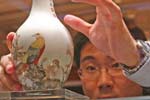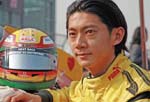Cars
Sponsorship for brand-building success?
Updated: 2011-04-08 11:07
By Mike Bastin (China Daily European Weekly)
Companies continue to pay vast sums of money to have their brands on Formula 1 cars. In fact, Formula 1 teams receive as much as 80-85 percent of their income from sponsorship while the rest comes from TV revenue and prize money.
Despite such inordinate sums of money involved and the intensity of competition for sponsorship of Formula 1 cars and drivers, there appears to be little or no research into the brand-building impact of Formula 1 sponsorship. Not just Formula 1 but sport generally continues to attract sponsorship and is regarded as an ideal form of brand association by a vast range of brand managers.
My brand management research, over many years, has revealed the need to understand each of the following in order to gain sufficient evaluation of the effectiveness of any sponsorship campaign:
1. Does the sporting event "fit" the desired brand values ?
Formula 1 enjoys a very distinctive image which avid watchers and race-goers would no doubt describe as "exciting", "hign-tech", "ultra modern" and "glitzy and glamorous". It is also a genuinely global sporting event with a target audience from all cultures and across all ages. Perhaps this global audience across such a vast age range explains why such a diversified rang of brands vie for sponsorship.
What will always remain most important to brand-building success though is the desired brand image among the brand's target market. Sponsorship will only succeed if there is a suitable match or "fit" here; and clearly for many brands involved heavily in Formula 1 sponsorship, this is far from the case.
For example, while HSBC might gain slightly from the "global" appeal of Formula 1, surely brand values in the banking industry should include, "trust", "safety and security" and "efficiency" and "reliability". Furthermore, banking brands do not stand to gain much from any association with "excitement" and "glamour". In contrast, high-tech companies such as Computer Associates and Hewlett-Packard, both long-time sponsors of Formula 1, may well enjoy more than favorable brand-building success.
2. Will the sporting event generate the required levels of brand awareness among the brand's target market?
If we assume that hign-tech brands successfully pass the "fit" test, we now have to examine just how successfully Formula 1 will reach the brand's target market and just how much race-time exposure will result. This will depend heavily on the Formula 1's team status and success and the position of the sponsor's name, logo, etc on the car and driver's clothing. And such high-profile exposure does not come cheap with sums reportedly up to $50 million (35 million euros) for title-chasing team sponsorship.
The real difficulty here, however, is the vast age range of the audience. This will not only make brand awareness measurement awkward, it may actually create confusion or even alienation in the minds of the most brand loyal consumers.
A further complication arises from the plethora of advertising messages that characterize every Formula 1 event. This makes it even more difficult to achieve effective brand exposure and also adds to audience confusion.
Brand managers can attempt to combat this, however, with innovative but subtle changes to their appearance on the car and/or driver's clothes. These subtle changes may benefit from knowledge of the "Just Noticeable Difference" concept, or JND for short. This "JND" is the smallest detectable difference between a starting and secondary level of particular sensory stimulus, in this case subtle changes in brand name, logo and livery.
3. Will the sporting event contribute sufficiently to the brand's image among the target market?
Even if our brand passes the "brand awareness" test, will this actually result in the desired level of brand image improvement? This is even more difficult to assess than brand awareness. Brand image measurement often involves reaching far into the deepest corners of the target markets' mind.
Among the many techniques used here are word association and brand personification. Word association simply involves pressuring people into revealing the first words that come to mind when they hear the brand name. If the sponsorship has been effective then some of these words will match the perception of the sponsored event. Brand personification attempts to gain an answer to the question: "If the brand was a person, what sort of person would it be?", which often reveals hidden brand associations which may also match the image of the sponsored event.
4. Will any contribution to brand image result in sufficient market share increase?
Finally, the acid test of sponsorship effectiveness is, hopefully, an increase in the brand's market share. Passing successfully through steps 1 to 3 is far from satisfactory if brand sales do not result. And even if a sales surge takes place, how easy is to identify the sponsorship as the root cause?
While projective techniques such as word association and brand personification may help here, a more recent development in brand management research, "experiential branding", often provides a telling insight into the motivation behind brand purchase. During this process, consumers may well reveal any contribution Formula 1 makes to their personal well-being.
Finally, while Formula 1 appears to expand more and more and reach a truly global audience with thrilling, daring and action-packed incidents, the above serves as a salutary lesson to all brand managers.
The author is visiting professor of brand management at China Agricultural University. He also teaches marketing and management at Tsinghua University.
Specials

Share your China stories!
Foreign readers are invited to share your China stories.

Art auctions
China accounted for 33% of global fine art sales.

Waiting for drivers' seat
Lack of sponsorship appears to be why Chinese drivers have yet to race in a Formula 1 event